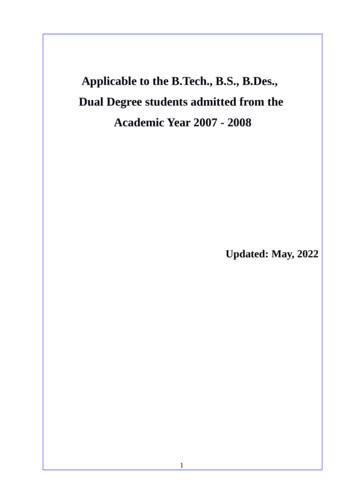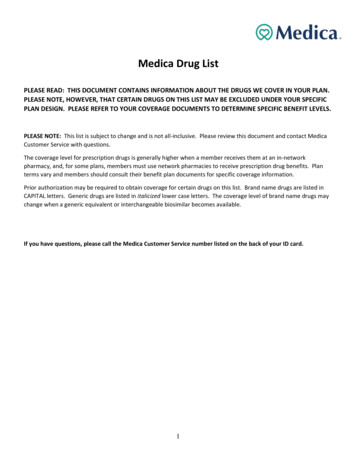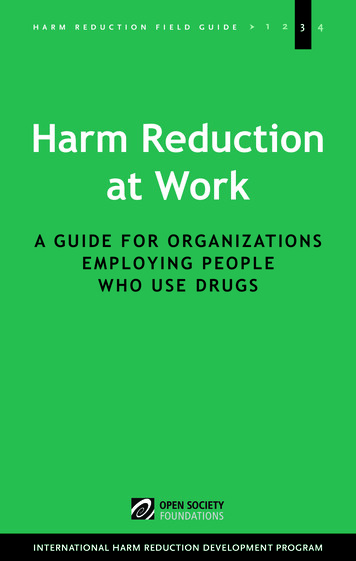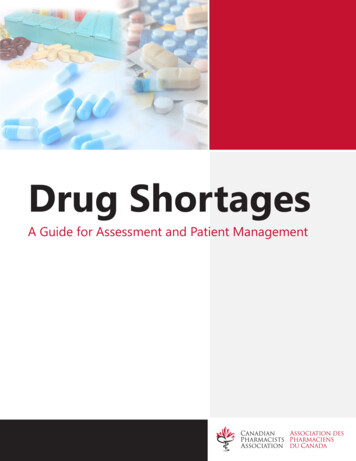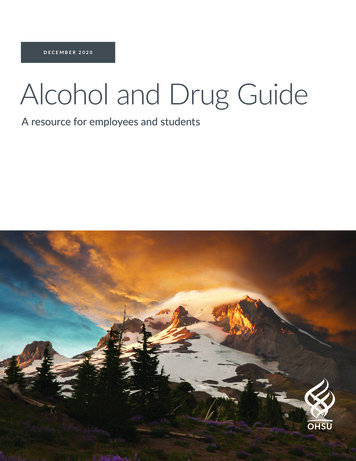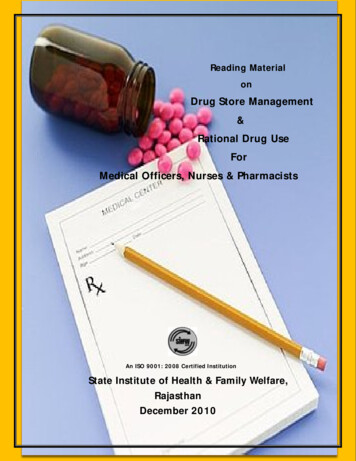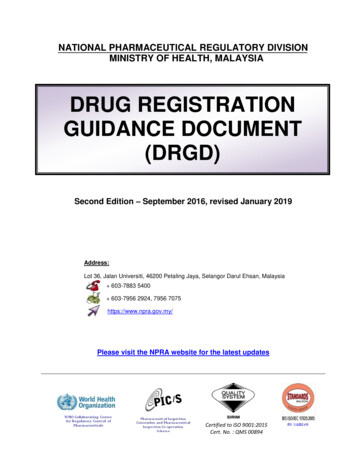
Transcription
Drug Registration Guidance Document (DRGD)NATIONAL PHARMACEUTICAL REGULATORY DIVISIONMINISTRY OF HEALTH, MALAYSIADRUG REGISTRATIONGUIDANCE DOCUMENT(DRGD)Second Edition – September 2016, revised January 2019Address:Lot 36, Jalan Universiti, 46200 Petaling Jaya, Selangor Darul Ehsan, Malaysia 603-7883 5400 603-7956 2924, 7956 7075https://www.npra.gov.my/Please visit the NPRA website for the latest updatesCertified to ISO 9001:2015Cert. No. : QMS 00894
Drug Registration Guidance Document (DRGD)GUIDELINE HISTORYNo.1.Guidelinea) Guidelines for Application forRegistration ofPharmaceutical Products,Third EditionDescription ofAmendmentEffective datea) October1993Initial Publicationb) December1998b) Permohonan PendaftaranKeluaran Ubat Tradisional,Second Edition2.Drug Registration GuidanceDocument (DRGD)Merging of1(a) and 1(b)* 20043.Drug Registration GuidanceDocument (DRGD),First Edition - January 2013Revision of DRGDNovember 20121st January 20134.Drug Registration GuidanceDocument (DRGD),Second Edition – September2016Revision of DRGD, FirstEdition - January 20131st September2016National Pharmaceutical Regulatory Division, Ministry of Health Malaysia.Second Edition, September 2016, Revised January 20192
Drug Registration Guidance Document (DRGD)This guidance document is issued by the Director ofPharmaceutical Services under Regulation 29,Control of Drugs and Cosmetics Regulations 1984.NPRA reserves the right to amend any part ofthe guidance document whichever it deems fit.All Rights Reserved.No part of this guidance document may be reproduced, stored in a retrieval system, ortransmitted, in any form or by any means, electronic, mechanical, microfilming,recording or otherwise, without written permission from the Senior Director ofPharmaceutical Services, Ministry of Health, Malaysia.National Pharmaceutical Regulatory Division, Ministry of Health Malaysia.Second Edition, September 2016, Revised January 20193
Drug Registration Guidance Document (DRGD)PREAMBLE This “DRUG REGISTRATION GUIDANCE DOCUMENT (DRGD)” will serve as thereference guide for the registration process including quality control, inspection &licensing and post-registration activities of medicinal products. This DRGD shall be read in conjunction with the current laws and regulationstogether with other relevant legislations, where applicable, governing pharmaceuticaland natural products for human use in Malaysia, which include but not limited to thefollowing:a)b)c)d)e)f)g)Sale of Drugs Act 1952;Control of Drugs and Cosmetics Regulations 1984;Dangerous Drugs Act 1952;Poisons Act 1952;Medicines (Advertisement & Sale) Act 1956;Wildlife Conservation Act 2010 (Laws of Malaysia Act 716); andInternational Trade in Endangered Species Act 2008 (Act 686).The written laws shall take precedence over this guidance document in any event ofdiscrepancy. The scope of this DRGD includes information relating to administrative requirementsand procedures for:a) Submission of an application for the registration of medicinal products, whichis based on the ASEAN Common Technical Dossier/ Requirements (ACTD/ACTR), where applicable;b) Submission of an application for the licensing of manufacturers, importers andwholesalers;c) Submission for amendments to a registered medicinal product; andd) Post-registration activities.National Pharmaceutical Regulatory Division, Ministry of Health Malaysia.Second Edition, September 2016, Revised January 20194
Drug Registration Guidance Document (DRGD) Applicants shall familiarize with the contents of this guidance document and thegoverning legislations before they submit applications for medicinal productregistration. The Authority may request for information or specify conditions not described in thisdocument that is deemed necessary to ensure the quality, safety and efficacy of theproduct. An on-going review of regulatory policies will continue taking into account the globalregulatory environment, to allow for timely and pertinent changes.For more information, please refer to Circulars and Publications. Applicants are advised to refer to NPRA’s website for the latest updates of theDRGD and other related guidelines. Separate guidelines are available forCosmetics and Veterinary products. The Authority reserves the right to amend any part of the DRGD whenever it deemsfit. Any enquiry on registration of products may be submitted to:Secretary,Drug Control Authority,National Pharmaceutical Regulatory Division,Ministry of Health Malaysia,Lot 36, Jalan Universiti,46200 Petaling Jaya, Selangor.National Pharmaceutical Regulatory Division, Ministry of Health Malaysia.Second Edition, September 2016, Revised January 20195
Drug Registration Guidance Document (DRGD)ABBREVIATIONS AND ACRONYMSACCSQPPWGASEAN Consultative Committee on Standards and Quality/Pharmaceutical Product Working GroupACTDASEAN Common Technical DossierACTRASEAN Common Technical RequirementAMVAnalytical Method ValidationANOVAAnalysis of VarianceAPIActive Pharmaceutical Ingredient (Interchangeable with drug substance oractive substance).ASEANAssociation of Southeast Asian NationsATCAnatomical Therapeutic ial Endotoxins TestBMFBatch Manufacturing FormulaBPBritish PharmacopoeiaBSEBovine Spongiform EncephalopathyCCLCentre for Compliance and LicensingCDCRControl of Drugs & Cosmetics Regulations 1984CEOChief Executive OfficerNational Pharmaceutical Regulatory Division, Ministry of Health Malaysia.Second Edition, September 2016, Revised January 20196
Drug Registration Guidance Document (DRGD)CEPCertificate of SuitabilityCEP is referring to Certificate of Suitability of European Pharmacopoeiamonographs issued by the EDQMCFCChlorofluorocarbonsCFSCertificate of Free SalesCIConfidence IntervalCMCChemistry, Manufacturing And ControlsCoACertificate of AnalysisCOHChange of Product Registration Holder (Previously known as Change ofMarketing Authorization Holder)COMBOCombination PackCOSChange of Manufacturing SiteCPPCertificate of Pharmaceutical ProductCTXClinical Trial ExemptionCTILClinical Trial Import LicenceDCADrug Control AuthorityDEData ExclusivityDMFDrug Master File (interchangeable with Active Substance Master File)DNADeoxyribonucleic acidDRGDDrug Registration Guidance DocumentEDQMEuropean Directorate for the Quality of Medicine and HealthcareELCEndotoxin Limit ConcentrationEMAEuropean Medicines AgencyEPEuropean PharmacopoeiaNational Pharmaceutical Regulatory Division, Ministry of Health Malaysia.Second Edition, September 2016, Revised January 20197
Drug Registration Guidance Document (DRGD)FDAFood and Drug AdministrationFDIFood-Drug InterphaseFEOFor Export OnlyFPQCFinished Product SpecificationFSQDFood Safety and Quality DivisionFTIRFourier Transform InfraredggramGABAGamma-Amino Butyric AcidGCGas ChromatographyGCPGood Clinical PracticeGDPGood Distribution PracticeGMPGood Manufacturing PracticeHACCPHazard analysis and critical control pointsHBsAgSurface Antigen of the Hepatitis B VirusHBVHepatitis B VirusHCVHepatitis C VirusHDPEHigh-density polyethyleneHIVHuman immunodeficiency virusHPLCHigh Performance Liquid ChromatographyHSHealth SupplementICHInternational Conference on Harmonisation of Technical Requirements forRegistration of Pharmaceuticals for Human UseINNInternational Non-proprietary NamesNational Pharmaceutical Regulatory Division, Ministry of Health Malaysia.Second Edition, September 2016, Revised January 20198
Drug Registration Guidance Document (DRGD)IPQCIn-Process Quality ControlISOInternational Organization for StandardizationJAKIMMalaysia Department of Islamic Development(Jabatan Kemajuan Islam Malaysia)JPJapanese PharmacopoeiaLLitreLALLimulus Amebocyte LysateLOALetter of AuthorizationLOCLetter of CommitmentLOILetter of IntentmAbmonoclonal antibodyMaVMajor VariationmaxmaximumMCBMaster Cell bankMDDCIMedical Device-Drug-Cosmetic InterphaseMiV-PAMinor Variation Prior ApprovalMiV-NMinor Variation NotificationmLmilliLitreMPNMost-Probable NumberMSMMethylsulphonylmethaneMVDMaximum Valid DilutionNational Pharmaceutical Regulatory Division, Ministry of Health Malaysia.Second Edition, September 2016, Revised January 20199
Drug Registration Guidance Document (DRGD)NATNucleic Acid TestingNCENew Chemical EntityNDPNew Drug ProductNMTNot More ThanNPRANational Pharmaceutical Regulatory DivisionNRVNutrient Reference ValueOTCOver-the-CounterPh. Eur.European PharmacopoeiaPIPackage InsertPIC/SPharmaceutical Inspection Co-operation SchemePMFPlasma Master FilePOAProtocol of Analysisppmparts per millionPRHProduct Registration Holder(Previously known as Marketing Authorization Holder, MAH)PSURPeriodic Safety Update ReportPVProcess ValidationRiMUPConsumer Medication Information Leaflet (RiMUP)(Previously known as Patient Information Leaflet or PIL)RNARibonucleic acidRSDRelative Standard DeviationSIRIMStandards and Industrial Research Institute of MalaysiaNational Pharmaceutical Regulatory Division, Ministry of Health Malaysia.Second Edition, September 2016, Revised January 201910
Drug Registration Guidance Document (DRGD)SPCSummary of Product Characteristicsspp.SpeciesSyn.SynonymTAMCTotal Aerobic Microbial CountTGATherapeutic Goods AdministrationTLCThin Layer ChromatographyTSETransmissible Spongiform EncephlopathiesTYMCTotal Yeasts and Moulds CountUSPUnited State PharmacopeiaUSPIUS Package InsertUVUltra-VioletVVMVaccine Vial MonitorWCBWorking Cell BankWHOWorld Health OrganisationNational Pharmaceutical Regulatory Division, Ministry of Health Malaysia.Second Edition, September 2016, Revised January 201911
Drug Registration Guidance Document (DRGD)GLOSSARYBulk Product: A product that has completed all processing stages up to, but notincluding, final packaging.Contract Manufacturer: Any person who manufactures any product on the order ofanother person to whom a manufacturer’s licence has been issued under theseRegulations (as defined in Regulation 2, CDCR 1984)Finished Product: A product that has undergone all stages of production and qualitycontrol, including packaging in its final container and labelling.Indigenous Medicine: As defined under Regulation 2, the CDCR 1984, indigenousmedicine means a system of treatment and prevention of disease established throughtraditional use of naturally occurring substances.Licensed Importer: A person to whom an import license has been issued underRegulation 12, CDCR 1984 (as defined in Regulation 2, CDCR 1984)Licensed Manufacturer: A person to whom a manufacturer’s licence has been issuedunder these Regulations, and includes a contract manufacturer (as defined inRegulation 2, CDCR 1984)Licensed Wholesaler: A person to whom a wholesaler's licence has been issuedRegulation 12, CDCR 1984 (as defined in Regulation 2, CDCR 1984)Manufacturer: A person carrying out one or more of the steps specified in the definitionof manufacture.Manufacture, in relation to any product includes –a) The making or assembling of the product;b) The enclosing or packing of the product in any container in a form suitable foradministration or application, and the labelling of the container and;c) The carrying out of any process in the course of any of the foregoing activities.(as defined in Regulation 2, CDCR 1984)National Pharmaceutical Regulatory Division, Ministry of Health Malaysia.Second Edition, September 2016, Revised January 201912
Drug Registration Guidance Document (DRGD)Medicinal Product: The term refers to ‘product’ as stated in Regulation 2, CDCR 1984which is applicable to pharmaceutical and natural productsOTC: Refers to Generic product (Non-Scheduled Poison)Product Owner: A person, company or entity who is the legal/ registered owner of theproduct formulation and/or process with whom the marketing authorization holder has acontract (glossary used in ACTD and ACTR).Product Registration Holder: The company or corporate or legal entity in the field ofpharmaceuticals whose name the marketing authorization has been granted. This partyis responsible to all aspects of the product, including quality and compliance with theconditions of marketing authorization. The authorized holder must be subjected tolegislation in the country that issued the marketing authorization, which normally meansbeing physically located in that country (glossary used in ACTD and ACTR).Repacker: *Please refer “Explanatory Notes for Repackers” as belowThe Authority: Refers to Drug Control Authority (DCA)The System: Refers to QUEST system in website of NPRA*EXPLANATORY NOTES FOR REPACKERS1. IntroductionThis chapter is intended to provide guidance to those engaged in repackaging offinished products with the aim to provide information to any person/ establishments whoremoves finished products from their original container-closure system and repackagesthem into a different container-closure system for sale and/or for distribution.2. Objectivesa) To provide uniform guidance and a means of assessing the operations ofrepackers/ relabelers as they relate to the provisions of the GMP and GDPrequirements.National Pharmaceutical Regulatory Division, Ministry of Health Malaysia.Second Edition, September 2016, Revised January 201913
Drug Registration Guidance Document (DRGD)b) To identify the type of repacking activity and whether there is a need to complywith GMP and GDP requirements.3. DefinitionsTermsDefinitionsManufactureManufacture, in relation to any product includes –a) The making or assembling of the product;b) The enclosing or packing of the product in any container in a formsuitable for administration or application, and the labelling of thecontainer and;c) The carrying out of any process in the course of any of theforegoing activities.PackagingAll operations, including filling & labelling, that a bulk product has toundergo in order to become a finished product. Filling of a sterile productunder aseptic conditions or a product intended to be terminally sterilized,would not normally be regarded as part of packaging.PackagingMaterialAny material employed in the packaging of a material or product orcosmetic, including any other packaging used for transportation orshipment. Packaging materials are referred to as primary or secondaryaccording to whether or not they are intended to be in direct contact withthe product.PrintedpackagingmaterialPackaging material which is imprinted with text or numbers or acombination of both.LabellingThe term ‘labeling’ designates all labels and other written, printed, orgraphic matter upon, or in, any package or wrapper in which it isenclosed, except any outer shipping container. A shipping container,unless such container or the outside of the consumer package, isexempted from labelling requirements.Labeller/relabellerA company that affixes the original label to a finished product (i.e labeller)or changes in any way the labelling on a product without affecting theproduct or its container (i.e. relabeller).PackagingsystemComposed of a container system with its closure. This system mayinclude several layers of protection for the Pharmacopeia preparationalong with any sealing devices, delivery devices, labelling and packageinserts.National Pharmaceutical Regulatory Division, Ministry of Health Malaysia.Second Edition, September 2016, Revised January 201914
Drug Registration Guidance Document (DRGD)TermsDefinitionsRepackerA company who removes a finished product from its final packaging andplaces the finished products into a different container which is labelled orto be labelled before the product is for sale and/or distribution for humanuse. Repacker may consist of primary and secondary repacker.PrimaryrepackerA company who performs repacking activity that places the finishedproducts into a primary/ immediate container which labelled or to belabelled before the product is for sale and/or distribution for human use.SecondaryrepackerA company who does the repacking activity relating toa) labelling of the product container; and/orb) packing the finished product which is already enclosed in its labelledprimary container into a carton which is labelled or to be labelled.before the product is for sale and/or distribution for human use.National Pharmaceutical Regulatory Division, Ministry of Health Malaysia.Second Edition, September 2016, Revised January 201915
Drug Registration Guidance Document (DRGD)4. Examples of types of repacking activityNo.1.Description of Repacking ActivityPacking/ blistering o aRequireGMP/GDPControlProduct to beincluded inManufacturingLicense ListResponsibility PrimaryrepackerproductdifferentRemarks (If any)2.De-blistering of blister strips of tablets/capsulesto repack into a new blister pack/container Primaryrepackere.g. Blister packs deblistered and repackinto new blister packduetomarketpurposes, etc.3.To form a secondary packaging material (unitbox) to pack blister strips, bottles, etc. into thispackaging material Secondaryrepackere.g. 5 strips in a unitbox to be repack to 1strip in a unit box4.To affix an immediate label to a container ofproduct that contains information such asProduct Name, Dosage Form, Name of ActiveSubstance(s), Strength of Active Substance(s),Batch Number, Manufacturing Date, ExpiryDate, Route of Administration, StorageCondition, etc. Primaryrepacker/SecondaryrepackerReferAppendix 9:Labelling Requirementfor Immediate Labels5.To affix label of outer carton that containsinformation such as Product Name, DosageForm, Name of Active Substance(s), Strength ofActive Substance(s), Batch Number,Manufacturing Date, Expiry Date, Route ofAdministration, Storage Condition, etc. SecondaryrepackerReferAppendix 9:Labelling Requirementfor Unit Outer CartonNational Pharmaceutical Regulatory Division, Ministry of Health Malaysia.Second Edition, September 2016, Revised January 201916
Drug Registration Guidance Document (DRGD)No.RequireGMP/GDPControlProduct to beincluded inManufacturingLicense Lista) Name & content of preservative(s) wherepresent *Xb) The words “Keep medicine out of reach ofchildren” or words bearing similar meaningin both Bahasa Malaysia & English *Xc) The words “Controlled Medicine/ UbatTerkawal” (For scheduled poisons only) *Xd) Security label (Hologram) *XDescription of Repacking ActivityResponsibilityRemarks (If any)Importer/PrimaryRepacker/SecondaryRepackerThe importer/ repackershallmaintaintherelevantdocuments(e.g. hologram records,stock card)e.g. Remove Germanypackage insert from theproduct and replacewith Malaysia specificPackage InsertTo affix country specific label requirements forMalaysia6.7.To insert new Package Insert/ to change originalPackage Insert into the inside of the secondarypackaging product (unit box) Secondaryrepacker8.To attach/ tape Package Insert on the outside ofthe secondary packaging product (unit box) Secondaryrepacker9.To inkjet the Product Registration Number onthe primary/secondary packaging material (unitbox) Primary/Secondaryrepacker10.To inkjet of the Manufacturing Date, Expiry Dateand Batch Number on the primary/secondarypackaging material (unit box) Primary/SecondaryrepackerNational Pharmaceutical Regulatory Division, Ministry of Health Malaysia.Second Edition, September 2016, Revised January 201917
Drug Registration Guidance Document (DRGD)Product to beincluded inManufacturingLicense ListResponsibility erNo.Description of Repacking ActivityRequireGMP/GDPControl11.To affix specific labelling requirement of aproduct 12.To inkjet/ affix label ‘Sample Not For Sale’/‘Physician’s sample not for sale’/ ‘Professionalsample not for sale’/ etc. onto the secondarypackaging material13.To affix label ‘Diimport/diedarkan oleh’ onto theprimary/ secondary packaging material *X14.To affix ‘Halal’ label onto the primary/ secondarypackaging material *X15.To shrink wrap several boxes or bottles together *X *X *XSecondaryrepacker/Importer *XSecondaryrepacker/Importer16.17.18.To repack finished products into tertiarypackaging materials without any changes to theproductTo repack several registered finished productsas a convenient pack for promotional sale onlywithout changing the product immediate and unitouter carton labelTo affix security seal onto the secondary/ tertiarypackaging material *Remarks (If r/ImporterRefer 16.5 Applicationfor a Convenient PackNational Pharmaceutical Regulatory Division, Ministry of Health Malaysia.Second Edition, September 2016, Revised January 201918
Drug Registration Guidance Document (DRGD)5. Additional notes5.1 * denotes that the repacking activity has to be done in a Good Distribution Practise(GDP) controlled or licensed facility.5.2 The repacking activities as listed in Para 4 is non-exhaustive. Product and licenseholders shall be responsible to ensure that the registered products are repacked inan appropriate manner and all relevant documents is maintained (batch packagingrecords/logbooks/inventory records/ procedures).5.3 The conditions of the product must meet the storage requirements as stated in theGood Distribution Practice Guideline by National Pharmaceutical RegulatoryDivision (NPRA).5.4 In deciding whether a particular bulk product is suitable for repacking, the repackershould take into consideration any available information from the manufacturer,published literature and any reference pharmacopoeia.6. References6.16.26.36.46.5Drug Registration Guidance Document; First Edition; January 2013Good Distribution Practice Guideline, 1st Edition; 2011Control of Cosmetic ProductsUSP 31; Volume 1, 2008Guidance for Industry Container Closure Systems for Packaging Human Drugs andBiologics; May 19996.6 Irish Medicine Boards Guide to Parallel Imports; AUT-G0006-4.96.7 WHO GMP: Main Principles for Pharmaceutical Products.National Pharmaceutical Regulatory Division, Ministry of Health Malaysia.Second Edition, September 2016, Revised January 201919
Drug Registration Guidance Document (DRGD)Glossary for Homeopathic Products:Active substance: Active substances are considered to be source materials processedby one or a sequence of homeopathic manufacturing procedures listed inpharmacopoeias in official use and other officially recognized documents (e.g. mothertinctures, dilutions or triturations).Diluent: Substance used for the preparation of a stock/ starting material or thepotentisation process and which may also represent the substance of the dosage form.Liquid diluents usually consist of purified water, aqueous solution, glycerol or ethanol ofa suitable concentration or for which there is an appropriate monograph. Thecommonest solid diluent is usually lactose monohydrate.Dilution: Dilution has two meanings in homeopathy: For a product, a dilution is a liquid homeopathic preparation which is potentised asdescribed below (see the definition of potentisation). Individual dilutions are alsocalled potencies; As a procedure, dilution means the de-concentration process of a liquid or a solidpreparation. One part of each stage in the preparation of a homeopathic medicinefrom its stock or previous dilution (potency) by adding one part of a previous solid orliquid phase to a predetermined weight or volume of the diluent (see Potentisationbelow). Dilution occurs at all stages of production of the homeopathic medicineswhether by addition of solid excipient in trituration or the addition of diluent in theliquid phase and succussion.Dosage form: a dosage form in homeopathy complies with any relevant specificationsfor that dosage form for which an appropriate characterization exists in apharmacopoeia in official use, or in other officially recognized documents. The mostcommonly encountered homeopathic dosage form, the globule (pillule or pellet), is asolid spherule which consists of lactose, sucrose or any other suitable vehicle. Usually,preformed globules are impregnated with a dilution or directly by a mother tincture. Thehomeopathic dosage form tablet is a solid preparation which complies with any relevantcharacterization in the pharmacopoeia in official use (or in other officially recognizeddocuments) for tablets. Homeopathic medicines in tablet form are either prepared byimpregnation of preformed tablets or by compression of triturations with the vehicle. Themost commonly used liquid homeopathic medicines are either alcoholic solutions or oralliquids.National Pharmaceutical Regulatory Division, Ministry of Health Malaysia.Second Edition, September 2016, Revised January 201920
Drug Registration Guidance Document (DRGD)Excipient: Substance needed for manufacturing a dosage form (used afterpotentisation) such as wheat starch and magnesium stearate for tablets. It may alsorepresent the substance of the dosage form.Homeopath: A qualified provider (practitioner) of homeopathic treatment.Homeopathic medicines: Any medicine prepared in accordance with a homeopathicmanufacturing procedure described by a pharmacopoeia in official use or other officiallyrecognized documents. A homeopathic medicine may contain a number of homeopathicpreparations.Homeopathy: Classical homeopathy is a system of medicine using preparations ofsubstances whose effects, when administered to healthy subjects, correspond to themanifestations of the disorder in the individual patients.Mother tincture (also called tincture): The initial homeopathic preparation made fromsource material that can be further potentised (also called “liquid stock”), sometimesused as homeopathic medicines, is regarded as the most concentrated form of afinished homeopathic medicine. Mother tinctures are obtained classically by macerationor percolation (sometimes also by digestion, infusion, decoction or fermentation)techniques from source materials according to a procedure prescribed by a recognizedhomeopathic pharmacopoeia. Sometimes a mother tincture corresponds to the firstdecimal dilution, “1D” or “1X” (10-1), mostly when dry plant material is used as startingmaterial.Nosodes: Homeopathic medicines prepared from disease products from humans oranimals; from pathogenic organisms or their metabolic products; or from decompositionproducts of animal organs.Potency: The denominated degree of serial trituration or dilution and succession that isreached for each homeopathic medicine. The degrees of dilution or potencies arenormally indicated by the letters D, DH or X for successive 1 to 10 (decimal) dilutions,the letters C, CH or K or CK for successive 1 to 100 (centesimal) dilutions while Q or LMdenote successive 1 to 50 000 (Hahnemannian quinquagintamillesimal) dilutions.Dilution by 1 to 10 denotes 1 part processed with 9 parts of diluent (Hahnemanniandecimal), dilution by 1 to 100, 1 part processed with 99 parts (Hahnemannian orKorsakovian centesimal), and so on. The number preceding the letters (e.g. D, C or LM)normally indicates the number of dilution steps employed (Table 1).National Pharmaceutical Regulatory Division, Ministry of Health Malaysia.Second Edition, September 2016, Revised January 201921
Drug Registration Guidance Document (DRGD)As a consequence of different views in various approaches in homeotherapy andbecause the notion of these terms may depend on the nature of the starting materials,the terms “high potency” and “low potency” cannot be defined unambiguously.Potentisation (also called dinamization): The combined process of serial dilution andsuccussion or trituration at each step in the manufacture of homeopathic medicinesfrom stocks. (According to the tenet of homeopathy, potentisation represents theprocess by which the activity of a homeopathic medicine is developed.)Table I: Potency tableCommondesignation(s)Examples1:10aX1X, 2X, 3X, etc.1:10aDD1, D2, D3, etc.1:10aDHDH1, DH2, DH3, etc.1:100bC1C, 2C, 3C, etc.C1, C2, C3, etc.1:100bCH1CH, 2CH, 3CH, etc.CH1, CH2, CH3, etc.1:100bCK1CK, 2CK, 3CK, etc.CK1, CK2, CK3, etc.1:100bK1K, 2K, 3K, etc.K1, K2, K3, etc.1:50 000aLM1LM, 2LM, 3LM, etc.1:50 000aQQ1, Q2, Q3, etc.Dilution ratioaFor1:10 and 1:50 000 dilution ratios only the Hahnemannian method of manufacture(multi-flask method) is used.bFor1:100 dilution ratios a C potency is assumed to use the Hahnemannian method ofmanufacture (multi-flask method) and can also be denoted as CH. When theKorsakovian method of manufacture (single-flask method) is used, the potency isdesignated as CK or K.Sarcodes: Homeopathic medicines made from healthy animal tissues or secretions. InGreek, sarcode means fleshly.National Pharmaceutical Regulatory Division, Ministry of Health Malaysia.Second Edition, September 2016, Revised January 201922
Drug Registration Guidance Document (DRGD)Source material (raw material, starting material, mother substance): Sourcematerial is the original raw material used for the production of homeopathic medicines.This material is obtained from natural sources, e.g. of botanical, zoological,microbiological, mineral, chemical, animal and human origin, or synthetic procedures.Source materials may undergo preliminary treatment in order to be further processed.Stock: Substances or preparations made from the source materials (e.g. bymaceration, succussion or trituration) used as starting points for the production ofhomeopathic medicines.National Pharmaceutical Regulatory Division, Ministry of Health Malaysia.Second Edition, September 2016, Revised January 201923
Drug Registration Guidance Document (DRGD)TABLE OF CONTENTSGUIDELINE HISTORY. 2PREAMBLE . 4ABBREVIATIONS AND ACRONYMS . 6GLOSSARY. . 12TABLE OF CONTENTS .
Document (DRGD) Merging of 1(a) and 1(b) * 2004 3. Drug Registration Guidance Document (DRGD), First Edition - January 2013 Revision of DRGD November 2012 1st January 2013 4. Drug Registration Guidance Document (DRGD), Second Edition - September 2016 Revision of DRGD, First Edition - January 2013 1st September 2016
